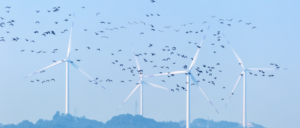The wind power sector continues to increase its contribution to the global power supply every year. Mitigating the major disadvantage associated with its operation – significant mortality rates for avifauna due to collision, barotrauma, etc. – has been the focus of extensive study in an effort to develop viable solutions. As such, several mitigation techniques have been developed with varying degrees of success. While some are very practical, such as painting turbine blades to increase visibility, or changing the surrounding lighting to a strobe setting, field studies have not been able to conclusively verify their results and applicability (Hotker et al., 2006, CMS, 2014). However, shutdown on demand (SOD) has proven to be an effective method of mitigation for wind farms in the operational phase.
The principle behind SOD is that stopping wind turbines in response to high-risk situations or in the presence of specific birds can effectively reduce the number of collision-related fatalities. It is especially valuable for windfarms situated in migratory pathways where there is variation due to weather or season, where vulnerable species are present, or where the assessment stage of development was unable to accurately predict the farm’s impact. Three different SOD systems are being used today: observation-based systems, image-based systems, and radar assisted systems.

Observation-based shutdown systems utilize highly experienced observers to assess incoming birds and initiate the shutdown of turbines. Organization and communication between observers are key in these systems to avoid double counting and to effectively analyze the situation. In a 2013 study by STRIX in Portugal, observers were sited at two locations within a windfarm and an additional five locations in a 4.5km radius. Using observation systems, a total shutdown period of 140 hours was recorded in 2010, 63 hours in 2011, and 47 hours in 2012, with the average shutdown event lasting 90 minutes and occurring on 32% of days. Throughout the three years of the study, no soaring bird deaths due to collision were recorded.
Rather than relying on the human eye, image-based systems use cameras to record their field of view as pictures or video sequences. When compared to observation-based systems, image-based systems can operate continuously, be fully automated, and even make use of the infrared wavelength to record in darkness. However, their field of view and resolution is more limited and can be prone to error-induced unnecessary shutdowns. Data gathered by DTBird in 2014 from five farms in Europe found that through the use of their image-based system, the number of shutdowns per turbine per year ranged from 1 to 315, with an average of 105. The number of those shutdowns that were falsely triggered varied from 1 to 28, while the average length of time the turbines were stopped for, whether correctly or falsely triggered, was only 3 minutes.
Radar-based systems utilize scanning or fixed-beam radar to detect incoming birds anywhere from 10km to as far as 200km away. In a study published by STRIX using their BirdtrackÒ software in combination with visual observers, they found that 45% of the time, radar detected shutdown-worthy bird detections (with a range between 6 and 12km) before any observers had flagged incoming birds (Birdlife International, 2015). Research in this field is ongoing to continue developing software that can classify species of birds using echo characteristics, speed, and wing beat frequency.

Observation, image, and radar-based systems are best used in combination with one another to address the disadvantages of each. As the systems and software continue to develop, these disadvantages will be minimized or eliminated, their advantages will grow, and ultimately, bird mortality will continue to decrease.
References
Birdlife International. (2015). Review and guidance on use of “shutdown-on-demand” for wind turbines to conserve migrating soaring birds in the Rift Valley/Red Sea Flyway. Regional Flyway Facility. Amman, Jordan. Retrieved from: http://migratorysoaringbirds.undp.birdlife.org/sites/default/files/msb_guidance_shutdown_on_demand.pdf.
DTBird. (2014). Case Studies: Shutdown on Demand. Retrieved from https://dtbird.com/images/Downloads/DTBird_Case_Studies_Shutdown_on_Demand.pdf.
STRIX BirdTrack. Retrieved from http://www.strix.pt/index.php/en/birdtrack.



